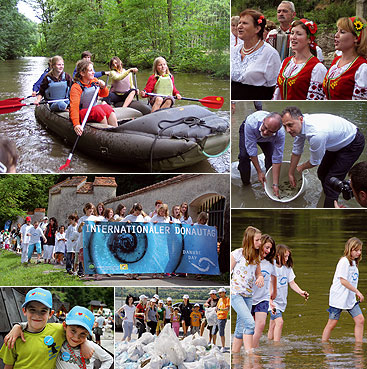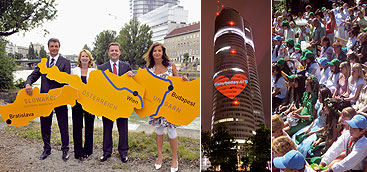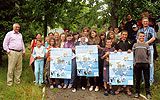DANUBE DAY 2009

DANUBE DAY
2009:
Shared
Waters –Joint
Responsibilities
Marking 15 years since the signing of the Danube Convention, Danube Day 2009 was a celebration of all that has been achieved. From a landmark Stakeholder Forum to events that created friends across borders, Danube Day was a success throughout the region.

Danube Day gets bigger and bigger each year: from cultural festivals and water games, to conservation seminars and river clean ups, activities offered everyone a chance to celebrate their ‘Danube Solidarity’.
It’s impossible to summarise danube day in a sentence: the sheer variety of events, organisations, nationalities, cultures and people involved, as well as the amount of energy and enthusiasm they generate, is mind-blowing. fourteen countries, each with their own mix of peoples, traditions and beliefs, varying histories, conflicts and politics come together on danube day to form one basin, united in celebration, united in their danube identity.
The 2009 theme, ‘Shared Waters – Joint Responsibilities’, emphasised the challenge of many countries working together. Events organised by over 420 national and international partners, such as the Coca-Cola System and Borealis, focused on finding ways to share the Danube waters without compromising the use and enjoyment by others – now and for the future.
“Through Danube Day, we declare our shared responsibility to protect our precious resource and together plan for a sustainable future,” said Philip Weller, Executive Secretary of the ICPDR.
Flowing in one direction. Danube Day engaged the diversity of people whose everyday actions affect the rivers. Only through joint understanding and mutual respect can a positive future be forged. The ICPDR’s Second Stakeholder Forum in Bratislava brought members of the agricultural, industrial, commercial and environmental sectors to discuss management of the rivers (see article, page 20). The ‘Greet the Danube’ horn blast reverberated across the basin, an acknowledgement by shipping companies that rivers are the source of their trade and require protection. Local stakeholder events in the Lower Danube sent NGOs from Ukraine and Moldova on a marathon boat tour, where a frank discussion with business leaders took place.
Danube Day is also about getting the message to as many of the 83 million inhabitants as possible. Events this year more than made this happen. High profile publicity, press events and widespread media coverage meant audiences could be counted in hundreds of thousands – in some cases, millions. In Vienna, you couldn’t fail to miss Danube Day as the logo was displayed for all to see on the colossal 202-metre-tall Millennium Tower. Opposite the Donauinselfest, two to three million festival-goers saw it beamed onto Vienna’s most famous skyscraper. Tulcea’s event was covered by 21 media organisations; Bosnia and Herzegovina national radio did a special broadcast and Ukrainian organisers said that “all Ukraine was watching or reading about this event!”
Ministers get their feet wet. Events this year saw Ministers wading into rivers, releasing fish, holding up giant jigsaws, handing out prizes and generally doing their utmost to promote the day. They hosted press conferences in five countries; in Dunasziget, Imre Szabo and other key officials, surrounded by press photographers, donned Wellington boots to release young sturgeon into the Zátonyi Danube.
“The Danube unites not only people, destinies and cultures, but energies and capacities which must be gathered in our efforts for the conservation and efficient use of the resources offered to us by the Danube Basin,” said Nicolae Nemirschi, Romanian Minister of Environment.
Mobilising for action. It wasn’t only politicians who got their hands dirty: in Bulgaria, Romania, Serbia and Ukraine people collected rubbish, putting a stop to plastic bottles on their tour of Danube countries. Inventive youngsters turned the rubbish into remarkably stunning ‘eco-fashion’.
In Croatia, experts discussed sustainable management;
Moldova held meetings with Lower Prut residents;
and in Serbia the Parties to the Sava Agreement signed
a protocol on water pollution from navigation (see article
page 12).

Through larger-than-life statements and huge crowds, events in Austria and Ukraine made it clear that everyone must get involved for our shared river basin.
Friends across borders. Rivers united neighbouring communities – a unifying force where once they were a line of division. The ‘Danube Challenge’ took young Austrians and Slovaks on an adventure from Linz to Bratislava. Joined by Olympian Christoph Sieber, they competed in watery challenges; pulling their ship over the border using just ropes and teamwork tested everyone to their limits.
Young people saluted the Danube with pedal power in the Green Bikes for Peace extravaganza. The 30-day Italy to Hungary action highlighted sustainability issues. Championing Danube Day in Linz, a raft was built from discarded plastic bottles to carry messages for a sustainable world. In Silistra, Bulgarians and Romanians met for a water sports contest. In Tulcea, a message from the Mayor of Ulm helped engender Danube solidarity from source to mouth.
The Danube Art Master contest helps develop the sense of Danube solidarity in children, resulting in thousands of pieces of art along rivers. Slovenia’s finale was held on the Island of Love, Prekmurje; Germany’s at the Weltenburg Monastery in Bavaria. A glance at the titles of winning artworks reveals the children’s strong message: “Danube – the way of peace”; “The Danube offers us life – but what do we give it back?” and “Danube – powerful song of the European countries”.

Children are an important part of Danube Day. Youngsters in Moldova proved that future generations will protect and preserve our precious resources.
Fun flows across the Basin. It wouldn’t be Danube Day without festivals: Hungarians celebrated in Dunasziget; young Moldovans sang traditional songs by the Prut; in Bratislava, a treasure hunt with a difference saw children pass through national checkpoints, learning from experts on the way. Belgrade’s family day and Galati’s water games were big hits. In Ukraine, thunderstorms didn’t dampen the spirits at the Tisza Children’s Festival: sudden downpours brought out the survival spirit in everyone. People got on and in their rivers; Czech Art Masters won a Morava safari and thousands enjoyed cruises.
“Looking back over previous years, we can see a growth in children’s knowledge and awareness of the Danube Basin … and their role in the protection of waters,” said Olena Marushevska from the All-Ukrainian Ecological League speaking about Danube Day in Dilove, Zakarpattya Oblast.
A jigsaw of nations. As a result of the work of governments, NGOs and businesses, Danube Day achieves more each year. Multiple events throughout the river basin brought people and cultures together, like the Danube puzzles launched this year.
“Fitting together the Danube jigsaw pieces symbolises the interdependence of Danube countries and their potential for cooperation,” said Andor Nagy, Chair of the Environmental Committee of the Hungarian Parliament.





